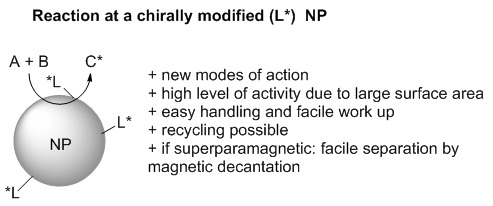
Functionalized nanoparticles
The focus of the Glorius group within the structure of the SoN is on the selective synthesis and characterization of metal and metal oxide nanoparticles and their application in important, particularly asymmetric catalytic reactions.
Despite the advanced development of the field of asymmetric catalysis (Nobel Prize for Chemistry 2001), only very few of these reactions are applicable to an industrial environment/scale. Problems arise from high costs, an insufficient space-time yield, low robustness and range of applications as well as difficulties regarding purification and recovery/recycling. However, in the area of heterogeneous catalysis, which is in industrial terms very popular, asymmetric variations are missing. Responsible for that lack is the in many times little understanding of heterogeneous catalysis (black box system) and poor structural manipulability.
Nanoparticles (NPs) could represent an interesting approach to bridge homogeneous and heterogeneous catalysis. Due to the small particle sizes high surface area-to-volume ratios are available, which is the reason for the high chemical/catalytic activity. Moreover, NPs can be influenced in their structure either in the course of their synthesis or afterwards. Applying chiral organic molecules (chiral modifier) to change the surface and to yield efficient catalysts for asymmetric catalysis is, up to now, a rather young and less investigated field. The modifier should be strongly bound to the NP, enhance the catalytic activity (active principle) and based on an active interaction with the substrates result in high activities and enantioselectivities. Furthermore, ideally the NPs should be stable and not lose any metal which is the basis for a long-term recycling of the catalyst. In our work we aim for a systematic investigation of NP synthesis, different modifiers and reactions as well as the underlying mechanisms and thus promote this economically and ecologically highly important, rather young research field.

